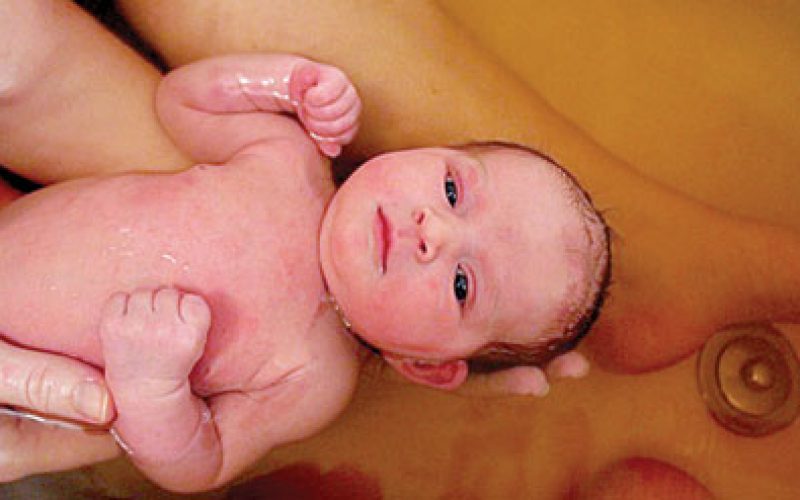
Photograph submitted
Iris Mae Dempsey in an herb bath given to the mother and baby following the birth. Midwife Maria Chowdhury explains that the bath has herbs specifically for healing. The benefits are also taking the baby back into an aquatic environment, where often they will open their eyes and begin to look around.
Iris Mae Dempsey is a healthy
4-month-old baby with a big smile and bright eyes. She knows how to stick out her tongue and spit for fun, and has recently discovered she has feet. It may be awhile, though, before she knows she was born at home in a birthing pool in the corner of her parents’ living room in the heart of Fayetteville.
Her parents remember the day well. It was more like 31 hours from the time Lisa Hinrichsen first realized she was going into labor until Iris came into the world.
The decision to have Iris at home was a conscious and educated decision, said Hinrichsen. Once she began to learn about the benefits of home birth, it seemed like common sense. Not to mention, a practice as old as human civilization.

Photograph submitted
Lisa Hinrichsen and her daughter, Iris Mae Dempsey. Hinrichsen and her husband are English professors at the University of Arkansas. They chose to have their daughter at home with the assistance of a midwife.
Like many, Hinrichsen and her husband, Sean Dempsey, first had to weed out the truth and hard facts from all of the messages sent out about birth and motherhood.
“We live in a culture where birth is surrounded by fear. If you watch a television show, it’s always people screaming, and they’re clamping down the women, and they’re giving her oxygen or she’s screaming for the epidural. Then there’s this alternative community who talk and write about positive birth stories,” Hinrichsen explained.
Birth stories show how women take what could be a birth experience controlled by many outside forces and decisions and transform it into their own personalized plan of action.
That’s an important aspect of Maria Chowdhury’s practice, Birth Song Midwifery. She’s one of several certified midwives in Northwest Arkansas, and the one Hinrichsen and Dempsey saw as their perfect fit.
Chowdhury thinks the most important part of her practice is beginning to make women aware of their innate abilities to birth a child.

Photograph submitted
Alissa Oxford, who lives in Farmington, and her daughter, Ava Moon, during a prenatal visit to midwife Maria Chowdhury.
“What I try to do for people is get them connected to their body. We’re a physical, female mammal. So if you can get in to your body through exercise, breath work, healthy eating, it will start to make you more aware of your authentic voice and ability to say ‘I want this; this, I don’t want.’” Chowdhury said.
The choices that Hinrichsen and Dempsey made for their birth may not have been possible in a traditional setting, she explained. Practices like waiting to clamp the umbilical chord until it stops pulsing to improve the baby’s immune system, or encapsulating the placenta as pills to help the mother with postpartum hormone transitioning, are not options in most hospitals throughout the country.
“Really just being in your own home and being able to drink and eat, walk around the (house), and do different yoga poses. You could push in your bathroom, you could light your own candles and listen to your music. You could be totally nude and not feel ashamed,” Hinrichsen said.
For many, the amount of care they receive through midwifery is one of its most attractive benefits. While Hinrichsen and Dempsey’s health insurance coverage paid for most of the birth, except special services like the placenta encapsulation, the amount of one-on-one care they experienced was much more than they would have received in a doctor’s office, and was a fraction of the cost.
After the basic risk assessment to determine their eligibility for home birth, women and their partners will visit Chowdhury twice a month during the first months of the pregnancy. These visits become more frequent and the monitoring of the mother and unborn baby more intense as the months go on, to include another risk assessment toward the end of the pregnancy. During the visits, Chowdhury and the mother finalize the birthing plan, including a hospital transport from the home in case of emergency.
Hinrichsen said some of her sessions with Chowdhury lasted about an hour, and the postpartum care included in the services allowed her to heal quickly and not feel obligated to take Iris out of the home in the first few important weeks.
Along with the prenatal, delivery and postpartum care, she teaches her clients about herbal and general nutrition, and holds a five-week birth class as part of her $3,000 fee. In these classes the women share their hopes, fears and knowledge about birth and being a mother. At the end of the five weeks the mothers share their appreciation for each other in a small ceremony where they swap last thoughts and a bead, with each bead representing a classmate, so the women never have to feel alone in their experience.
What’s most interesting about these classes, explained Chowdhury, is the diversity of people who come together for the common cause of healthy birthing.
“Sure, there’s a hippie, and there’s a missionary. And they’re both probably totally radical, but they sit on the same couch. I have PhDs, chiropractors, physicians, college girls, and 42-year-old women on their fifth baby. It’s not one type of person. It’s people that want to have control over their birth experience,” Chowdhury said.
She thinks midwifery has started to once again catch the attention of women because of the ability to share knowledge through the Internet, along with several well-known documentaries in the midwifery world like “The Business of Being Born” and “Orgasmic Birth,” released within the last five years.
“There are now all of these girls blogging, and women getting out there and beginning to realize they have options, and they weren’t alone in feeling like they wanted to stand up or drink and eat an apple (during labor),” she said.
Still, midwives must fight many stereotypes left over from the campaign to eradicate midwives in the 1930s by physicians who thought births should only be monitored by those who had attended a formal medical school. Midwives were portrayed as the lowest class of citizens who were barbaric, sometimes evil and definitely uneducated in the Western sense. Through legislation and public campaigns, midwifery was almost eradicated from the United States during this time.
Chowdhury explained while there are still some midwives practicing with little education; many, including herself, are certified, licensed and monitored by the state and through peer reviews. They use necessary modern equipment, keep medical charts, have good relationships with local hospitals and have attended many births before stepping out on their own.
Birth Network of Northwest Arkansas, stationed in Bentonville, is one local organization trying to spread the word about birthing options.
“We work to help women get all the information they need to make informed decisions for pregnancy, birth and newborn care. We feel like there are a lot of people out there telling women what to do. We want to be a resource for women so they can make their own decisions,” explained Birth Network NWA co-leader Genet Jones.
They do this through local directories and monthly classes where birthing options are discussed, along with their benefits and downfalls.
“There are a lot of things about pregnancy and birth that are going to affect mom and baby’s relationship and their lifelong health. Even if a women decides she wants to go along with what her doctor recommends, it’s important for women to know what their choices are and to be able to say ‘I made this choice for a reason,’” she said.
Take it from a new dad, Dempsey said. The bright look in Iris’ eyes and alertness to the world from the very beginning made him realize all of their education in birthing had paid off, with what is now a smiling, and adorable, baby girl.
Midwives help women with the innate ability to birth a child










